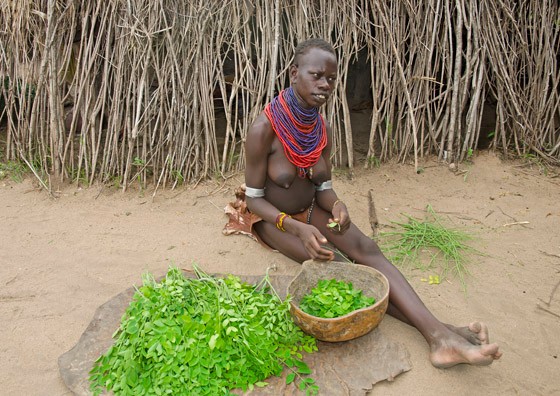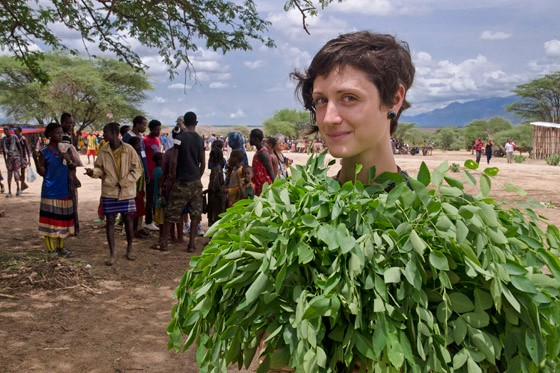
Its green leaves contain more calcium than cow's milk
and more iron than spinach
HAROLD CASTRO & GISELLE PAULINE ( TEXT AND PHOTOS ) |
DO RIO OMO VALLEY , ETHIOPIA

Karo woman removes green leaves of Moringa stems to prepare meal
( Photo: © Haroldo Castro / season )
Few Brazilians have heard of a plant called Moringa. Native to
Asia and Africa, the tree of up to 12 meters high provides abundant
branches laden with small green leaves.
Considered as a panacea for many ills - treatment of malaria
stomach pains - and a food with high nutritional value and an
excellent composition of protein, vitamins and
minerals, the Moringa tree is one of those that all inhabitants
of the tropics should
have in the backyard.
Of the 14 identified species, two are the most popular. Native
to the Himalayan slopes, Moringa oleifera has been recognized
by Ayurvedic medicine as an important medicinal herb for four
thousand years. The Indian plant was eventually spread
throughout the world and came to Brazil.
A related species is the Moringa stenotepala, native to eastern
Africa. According to
researchers at the University of Addis Ababa, Ethiopia, researching
the plant for nearly two decades, moringa has a high ability to
fight different tropical diseases such as
leishmaniasis.
But what haunts nutritionists is its composition as food.
Researchers concluded that,
gram for gram compared with other products, moringa has seven times
more vitamin C than oranges, four times more vitamin A than carrots,
four times more calcium than cow's milk, three times more iron than
spinach and three times more potassium than bananas. What's more,
the composition of its protein shows an excellent balance of
essential amino
acids (those who need to eat because the human body does not
produce them).

In a country remembered for malnutrition images, note that
the Ethiopian moringa -
Moringa stenotepala kind - is abundantly planted in the tropical
zone of the country
gives us great enthusiasm. On the road out of Arba Minch towards
the south, the tree is spread in various fields of corn, as well
as around the straw huts of the inhabitants of the region.
About 90 km later we arrived in Konso, the gateway to the native
territory of the people of the valley of the Omo River. The
traditional villages of Konso ethnicity were
proclaimed by UNESCO World Heritage Site in 2011 due to the
terraces created for
agriculture and stone walls that protect human settlements.
Not only that the ingenuity of Konso with their terraces,
enabling sustainable
agriculture in arid mountain slopes, the ethnic leaders plant,
for generations, moringa trees around their homes. Thus, the so
nutritious green leaflet no shortage to anyone in the community
and brings a minimum of nutrients to the entire population,
especially to children.

Thanks to abundant moringa and cereals and legumes planted in
Konso terraces , the
malnutrition ghost departs increasingly from southern Ethiopia.
In fact, in all the weekly markets in the region , we always
find bunches and bunches of fresh moringa being
sold to those who do not have a tree in your yard.
Thamyres Matarozzi , a São Paulo photographer traveling with
our small group of Brazilians already knew the fame of moringa
since 2011 when he lived in London. For being vegan and seek a
conscious power , Thamyres bought in Europe dozens of moringa
powder bags to complement a possible lack of proteins or
vitamins for his trip to Ethiopia. What was
his surprise to see that almost all of the restaurants where
we ate offered moringa -
or, in the local language , aleko - in various forms, from
soup to stew!

Moringa provides yet another gift to rural communities.
Due to a particular composition of the oils and proteins
contained in seeds, when ground and mixed with a blurred and
non-potable water, extraordinary reaction takes place: the
water becomes clear. How does this happen? The powder of
Moringa seeds has the property of attracting clay, sediment
and bacteria, which end up in the bottom of the container and
leaving the clear, clean
water.
Both the seeds of Ethiopian species (Moringa stenopatala) and
Asian (Moringa oleifera)
have the same characteristics of decant water. Researchers at
the Institute of
Agricultural Sciences, Federal University of Minas Gerais
proven in laboratory tests
that the seeds of the Asian moringa can remove 99% of the
water turbidity.
With all these attributes, it is not difficult to consider
the moringa as one of the
most generous plants on the planet. Therefore, several human
development NGOs that fight poverty and hunger call it
"super plant", "miracle tree" or "sheet that saves lives."
Once you know all this, our next step will be to buy seeds
and planting moringa at home!
Source:http://epoca.globo.com/colunas-e-blogs/viajologia/
noticia/2015/06/moringa-arvore-magica-que-pode-acabar-
com-fome-no-mundo.html
Click Here For More Articles

No comments:
Post a Comment